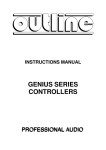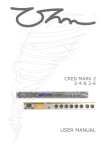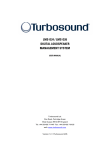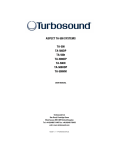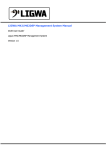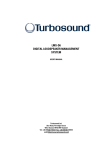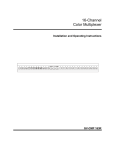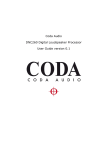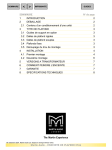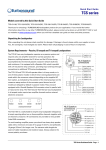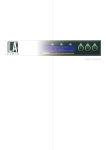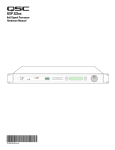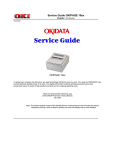Download LMS-D24/26 - Arizona Church Sound
Transcript
LMS-D24 / LMS-D26 DIGITAL LOUDSPEAKER MANAGEMENT SYSTEM USER MANUAL Turbosound Ltd. Star Road, Partridge Green West Sussex RH13 8RY England Tel: +44 (0)1403 711447 Fax: +44 (0)1403 710155 web: www.turbosound.com Version 1.2 user manual LMS-D24/26 QUICK REFERENCE (LMS-D26 shown) Display The LCD displays preset and parameter information. At start up the display shows the default screen with the memory location and name of the current preset on the lower line of text. Channel Select Buttons The currently selected input or output channel is shown in the top left corner of the display. Pressing the channel select buttons scrolls through the available inputs and outputs. If operating stereo linked the channel name will indicate the channel association. For example ‘CH A+B’ means both input A and B parameters. Edit Select Buttons The name of the edit parameter is displayed in the bottom left portion of the LCD. Pressing the edit select buttons moves through the available parameters for the current input or output. Parameter Encoders Up to three parameters are shown on the display. The parameter name is shown with its’ current value below. Where appropriate parameters are grouped according to function for example centre frequency, width and gain for parametric EQ. Turn an encoder clockwise to increase the value of a parameter, or anti-clockwise to decrease it. Turning a knob rapidly will cause the action to ‘accelerate’, so the value changes more rapidly. Mute Buttons The LED’s next to the mute buttons indicate their current status. Pressing a mute button toggles between the mute on and off. Store Button The unit has 45 memory locations and allows users to set up their own programs. To store a preset in a location, press the store button and use the encoders to select the memory location and name the preset. Pressing the store button again completes the task. Pressing any button other than store during the process cancels the procedure. LMS-D2X user manual Page 2 user manual LMS-D24/26 CONTENTS Quick reference ..................................................................................................................................................... 2 Display............................................................................................................................................................... 2 Channel Select Buttons.................................................................................................................................... 2 Edit Select Buttons ........................................................................................................................................... 2 Parameter Encoders ......................................................................................................................................... 2 Mute Buttons .................................................................................................................................................... 2 Store Button...................................................................................................................................................... 2 Important Safety Information .............................................................................................................................. 5 Regulatory Compliance ................................................................................................................................... 5 Thanks ............................................................................................................................................................... 6 Unpacking the controller ................................................................................................................................. 6 Introduction ...................................................................................................................................................... 7 Features............................................................................................................................................................. 7 The User Guide ..................................................................................................................................................... 8 Front Panel Functions ...................................................................................................................................... 9 Rear Panel Functions ..................................................................................................................................... 11 Operating the LMS series controller ................................................................................................................. 12 Starting up ...................................................................................................................................................... 12 Selecting a Factory Preset ............................................................................................................................. 12 Creating a Crossover...................................................................................................................................... 12 Navigation and Viewing Parameters ............................................................................................................ 13 Navigation....................................................................................................................................................... 14 Presets ............................................................................................................................................................. 15 Preset Recall ................................................................................................................................................... 15 Preset Store .................................................................................................................................................... 16 DSP Processing Layout ...................................................................................................................................... 17 Input DSP block diagram ............................................................................................................................... 17 Output DSP block diagram ............................................................................................................................ 17 Stereo / Mono Formats .................................................................................................................................. 17 DSP processing ................................................................................................................................................... 18 Input Channels................................................................................................................................................ 18 Parametric Equalisation ................................................................................................................................. 20 High and Low shelving filters ........................................................................................................................ 20 Parametric filters ............................................................................................................................................ 20 Output Channels ................................................................................................................................................. 21 Gain and Polarity ............................................................................................................................................ 21 Delay................................................................................................................................................................ 21 High and Low Pass Filters ............................................................................................................................. 22 LMS-D2X user manual Page 3 user manual LMS-D24/26 Parametric Equalisation .................................................................................................................................23 Limiters ............................................................................................................................................................24 Routing ............................................................................................................................................................24 Utilities .................................................................................................................................................................25 Utility functions ...............................................................................................................................................25 Factory Presets ....................................................................................................................................................26 EQ and Filter Response Graphs .........................................................................................................................27 Technical Specifications .................................................................................................................................30 Warranty ..............................................................................................................................................................31 NOTES .............................................................................................................................................................32 LMS-D2X user manual Page 4 user manual LMS-D24/26 IMPORTANT SAFETY INFORMATION Please read carefully and keep the following instructions and safety information. Heed all warnings and follow all instructions. • Do not remove covers. There are no user serviceable parts inside, please refer servicing to qualified service personnel. • This equipment must be earthed. • Protect the power cord from being walked on or pinched particularly at plugs, convenience receptacles, and the point where they exit from the apparatus. • Only use attachments/accessories specified by the manufacturer. • Servicing is required when the apparatus has been damaged in any way, such as the power supply cord or plug is damaged, liquid has been spilled or objects have fallen into he apparatus, the apparatus has been exposed to rain or moisture, does not operate normally, or has been dropped. Regulatory Compliance This product complies with both the EMC Directive (89/336/EEC) and the Low Voltage Directive (73/23/EEC) as issued by the Commission of the European Community. Compliance with these directives imply conformity with the following European standards: • EN60065 Product safety • EN55103-1 Electromagnetic Interference (Emission) • EN55103-2 Electromagnetic Susceptibility (Immunity) This product is intended for operation in the E2 (commercial & light industrial) and E3 (urban outdoors) Electromagnetic Environments. LMS-D2X user manual Page 5 user manual LMS-D24/26 Thanks Thank you for choosing a TURBOSOUND LMS series controller for your application. Please spare a little time to read the contents of this manual, so that you obtain the best possible performance from this unit. All TURBOSOUND products are carefully engineered for world class performance and reliability. If you would like further information about this or any other TURBOSOUND product, please contact us. We look forward to helping you in the near future. Unpacking the controller After unpacking the unit please check carefully for damage. If damage is found, please notify the carrier concerned at once. You, the consignee, must instigate any claim. Please retain all packaging in case of future re-shipment. LMS-D2X user manual Page 6 user manual LMS-D24/26 Introduction The Turbosound LMS series of loudspeaker management systems represents the current state-ofthe-art in digital electronics. The LMS-D24/26 are compact and powerful DSP based audioprocessing units designed for use with Turbosound loudspeaker systems and associated bass enclosures, combining the functions of multiple conventional products in a compact 1U high 19” rack unit. To achieve this the LMS-D26 has 2 inputs and 6 outputs (the LMS-D24 features four outputs), which are configured by different factory presets to allow use with a variety of systems. The units are designed to provide specific equalisation and crossover points aimed at optimising the performance of these Turbosound loudspeaker systems. In addition, limiters, delays eq, gain, polarity, and crossover filter controls are accessible to the user in order to match specific operation environments. The LMS series crossovers are designed for quick setup and adjustment via easy-to-use front panel controls. Features • Minimal signal path design, providing exceptional audio quality with carefully optimised processing and high performance converters for a full >111dB dynamic range, 96kHz sampling rate and minimal filtering. Audio-grade capacitors are used in the analogue signal path. • Sonically superb ADC / DAC combination; a carefully matched pairing of the best devices from Burr Brown and Wolfson. • Newly released family of Analogue Devices SHARC DSP. • Extended bandwidth; 96kHz sampling frequency provides for a nominally flat response to 40kHz. • Front panel parameter rotary encoder provides a familiar and easy to use control format with all filter information displayed simultaneously on a backlit LCD display. LMS-D2X user manual Page 7 user manual LMS-D24/26 THE USER GUIDE This user manual gives a progressively more detailed description of the functions of the TURBOSOUND LMS-D26 and LMS-D24 loudspeaker management systems. A single page quick reference guide is provided for those users who are experienced with this type of equipment and just need to know how to ‘drive’ the front panel. A detailed explanation of the front and rear panel controls and indicators is contained in the next section. The final section describes each individual function or feature with annotated images explaining its use. Where appropriate, the LCD is shown to further elaborate on the unit’s operation. To complete the manual a reference section is included, describing the technical performance of the device complete with graphs of filter responses and details of the Factory Presets and their configuration. LMS-D2X user manual Page 8 user manual LMS-D24/26 Front Panel Functions Channel Select buttons Store and Recall buttons Input Signal Indicators 2x 24 character LCD Limiter Indicators Parameter Edit Encoders Edit Parameter Select buttons • Output Mute buttons Input Signal Indicators – A set of three pairs of LED’s indicate signal present, +4dBu and input clip for both channels. The signal present LED’s operate at approximately –40 dBu, giving a useful indication of even relatively low input signal levels. The +4 dBu LED’s are intended to show nominal operating level and can also be useful for setting system gain structure. Clip LED’s warn the user of input overload and operate at +19 dBu. • Program Store and Recall – these controls provide access to 45 presets. Pressing the store button allows the user to name a preset and choose which memory location it will be held in. Pressing store button again completes the process. The Recall function operates in a similar way, pressing the recall button allows the user to select which preset they require, pressing the button for a second time, then confirming, recalls the new DSP settings. The unit allows the user to set up user programs with full access to all parameters. Note that presets cannot be stored or recalled when secure mode is activated. • Channel Selection Buttons – the currently selected channel is displayed on the top left hand corner of the LCD. Pressing the channel buttons scrolls through the available input and output channels and finally through the utility functions and back to the default screen. If operating a stereo-linked preset the channel name will indicate the channel pairing. For example ‘A+B’ means both input A and B parameters. The name of the output will be shown briefly at the top of the display when stepping onto an output. LMS-D2X user manual Page 9 user manual LMS-D24/26 • Edit Select Buttons – the currently selected edit parameter is displayed on the bottom left corner of the LCD. Pressing the edit select buttons moves through the available parameters for the current input or output. • Text display – preset, channel, parameter and status information is shown on the 2x 24character text display. In most screens the currently selected channel is displayed on the upper line and the edit parameter on the lower line. To simplify the display and enhance security, some parameters or parameter pages are omitted when not relevant. • Parameter Knobs – three velocity sensitive parameter knobs are used to adjust parameters shown on the display. Up to three parameters are displayed on the screen. The parameter name is shown above the parameter value in each of the three screen sections. The parameter knobs have a fixed association with the screen sections; the rightmost parameter knob adjusts the rightmost parameter and so on. • Output signal and limiter indication – two LED’s are provided for each output channel. These show the signal level relative to the limiter threshold. The yellow LED will light when the signal is 6dB below the threshold and the red warning LED will light when the limiter threshold is reached. • Mute buttons and status LED’s – each output has a mute button and associated mute status LED. Pressing the button toggles the mute on and off. • Note that the mute buttons do not function when the Secure Mode is activated. • Secure Button (on the rear) – a momentary button is fitted behind the rear panel, between the output XLRs and the RS232 port. When activated, this will disable all the front panel controls so they cannot affect the signal path, making the unit secure against tampering. When in secure mode, the indicators still operate normally. Note that the communications port is still active in secure mode. LMS-D2X user manual Page 10 user manual LMS-D24/26 Rear Panel Functions Expansion Port Power Inlet Secure Mode Switch Audio Input Connectors Serial Comms Port Audio Output Connectors • Power Inlet – provides connection to a suitable mains electricity supply using the cable supplied. The controller has a switch mode power supply that is capable of operating with a nominal mains voltage of 80 to 240v, 50/60Hz without re-configuration. • Network expansion port – where a future network card can be fitted. • Audio Input connectors – these are fully balanced and are wired pin 1 ground, pin 2 hot and pin 3 cold. The two inputs have pin 1 connected directly to the chassis and feed the signal processing chains. If an unbalanced source is used, a connection should be made between the pin 3 ‘cold’ signal and the ground connection of the unbalanced source. • Audio Output connectors – the processed outputs are impedance balanced, and are wired pin 1 ground, pin 2 hot and pin 3 cold. An unbalanced input may be driven by by connecting pin 3 ‘cold’ signal to the ground connection of the unbalanced destination input. Note that output pin-1’s are ground lifted at audio frequencies but connected to ground at RF for good EMC performance. The intention being that the amplifiers the processor is driving should be responsible for the grounding of their input cable shields. • Communications port connector – the unit may be controlled entirely from another controller (typically a Personal Computer), running an application that is compliant with the ObCom standard. Connection will normally be made to the controller via this serial port connector. This port is also used for updating the firmware in the unit. Note: The communications port is NOT disabled when the front panel is made secure using the secure button. LMS-D2X user manual Page 11 user manual LMS-D24/26 OPERATING THE LMS SERIES CONTROLLER Starting up The unit will energise as soon as power is applied to the IEC inlet; there is no power switch. During the start up process the firmware application model number and version numbers are displayed and the outputs are muted until the unit has completed its internal checks. Once the start-up routines are complete and the unit is ready to pass audio, the DSP signal path will be restored to the current settings when it was last powered down and the audio signal is gradually ramped up to its correct level. Selecting a Factory Preset There is a library of thirty Factory Presets to suit a range of Turbosound enclosures. Factory Presets contain some parameters that are fixed and hidden from view; the remainder of the DSP parameters are available for user manipulation. The number and type of hidden parameters is dependant on the Factory Preset, typically crossover frequencies, output delay and some EQ’s are hidden; those settings that are a function of the loudspeaker cabinet design and should not require adjustment for different applications. To recall a Factory Preset for a particular cabinet or system, press Recall and use the left hand parameter knob A to scroll through the available factory preset locations (as indicated by a box symbol after the preset number). Once the appropriate preset has been selected press recall again, at which point you will be asked to confirm the action by pressing recall for a third time. This is to guard against accidental recall of Presets. Factory Presets are locked so they cannot be over-written. The user can, however, store an edited version of a Factory Preset in any free preset location. Details of all the Factory Presets can be found in Appendix A. Creating a Crossover In addition to the Factory Presets the unit has two further ‘Base Presets’; mono and stereo. These Base Presets are stored in locations 1 and 2 respectively, they can be used to develop settings for any loudspeaker combination and are recalled in the same way as the Factory Presets described above. These Presets are also locked but the user can name and store their own edited versions in any free preset location. LMS-D2X user manual Page 12 user manual LMS-D24/26 Navigation and Viewing Parameters (Note: The LMS-D26 is shown in all the following screen shots; however the features and parameters apply equally to the LMS-D24) Many of the processing elements in each input and output path have features that may be controlled by the user, such as gain, frequency or limiter threshold. We call these adjustable features parameters. LMS-D26 In A Freq EQ1 100Hz Width 1.4Q b a a b Gain 0.0dB c c A parameter may be adjusted when it is displayed by turning one of the three-parameter knobs. Each of the three-parameter knobs is associated with a zone on the display. Adjusting the leftmost parameter knob will change the value of the parameter showing in the leftmost zone of the display and so on. Turn a knob clockwise to increase the value of a parameter, or anti-clockwise to decrease it. The knobs are velocity-sensitive so turning a knob rapidly will cause the action to ‘accelerate’, so the value changes more rapidly. LMS-D2X user manual Page 13 user manual LMS-D24/26 Navigation The DSP parameters are organised by channel. The currently selected channel is shown in the top left hand corner of the display. You can navigate between the channels by pressing the channel buttons. Pressing the channel buttons will scroll through the channels, utilities and back to the default screen. When using a Preset that is stereo linked, the channel selection will reflect this. For example ‘1&4’ indicates outputs 1 and 4. When navigating onto an output channel, the usage of the output, as define in the factory preset, will be shown briefly at the top of the screen. CHANNEL LMS-D26 EDIT Out1 Freq EQ1 100Hz a Width 1.4Q b Gain 0.0dB c Pressing the edit navigation buttons gives access to the various pages of parameters available for each channel. The currently selected page is shown in the bottom left hand corner of the display, this is omitted on some pages where the function is obvious. The screen shows up to three (normally related) parameters for a given part of the processing functions on a given channel. The edit buttons allow you to scroll, in either direction, through the different processing pages for a given Channel. When you go past the last page, you will be returned to the default page. The channel buttons allow you to scroll, in either direction, through the input and output channels, whilst trying to maintain the currently viewed processing block. If the channel you scroll to does not have the currently viewed processing block, the next one will be shown instead. NB. When the unit powers-up, the settings will be the same as those when the unit was last switched off. LMS-D2X user manual Page 14 user manual LMS-D24/26 Presets The device contains a total of forty-five user and Factory Presets. The user cannot overwrite the basic mono, basic stereo or Factory Preset programs. Preset Recall To select an existing Preset, press the Recall Button so the indicator above it illuminates. Turn parameter knob A until the required Preset number is shown on the display. Factory presets are indicated by a box symbol appearing after the preset number. Press the Recall Button again to activate the Preset. Pressing any other button will cancel the operation. LMS-D26 Preset Name Recall 32 My System a RECALL SELECT PRESET TO RECALL b c RECALL a Users can develop their own Preset based on one of the basic or Factory Presets stored within the device. Once a basic or user Preset has been recalled, a user has complete freedom to adjust any or all of the parameters. Factory Presets can be used as the basis for user Presets but they have some parameters that are predefined as a function of the loudspeaker system. These parameters are ‘hidden’ from the user, as they should be constant regardless of application. LMS-D2X user manual Page 15 user manual LMS-D24/26 Preset Store To store the current Preset in a user location, press the Preset Store Button so the indicator above it illuminates. Turn the first parameter knob until the required Preset location number is show on the display. A Preset name of up to 12 characters in length can be entered using parameter knobs B and C. Pressing the Store Button again completes the process and stores the Preset. As with Preset Recall, pressing any other button cancels the operation. LMS-D26 Preset Name Store 32 My System a STORE b c SELECT STORE LOCATION a STORE b c NAME PRESET The user can overwrite non-protected Presets only; if an attempt is made to save a Preset in a location already occupied by a basic or Factory Preset a ‘LOCKED PRESET’ message is displayed. LMS-D2X user manual Page 16 user manual LMS-D24/26 DSP PROCESSING LAYOUT Input DSP block diagram Input A Input LED’s Input Gain Delay 4th Order HPF Low Shelf EQ Six Band PEQ High Shelf EQ Routing SUM - 6dB NB. Channel B processing is identical to Channel A but for clarity it is not shown Input B Output DSP block diagram Delay 8th Order HPF 8th Order LPF Low Shelf EQ Six Band PEQ High Shelf EQ Output Gain Mute Limiter Routing Metering Stereo / Mono Formats There is only one ‘standard’ layout of the processing blocks, but flexible routing and control linking allows this layout to be adapted to a wide variety of applications. There are two ‘Formats’, Mono or Stereo. With the Mono format, all outputs have unique parameter settings, and all outputs are identical in terms of processing functions and routing capability. This is the most flexible Format. Stereo format pairs the inputs and outputs for stereo operation, the parameters of each member of the pair being identical. The routing of inputs to outputs is fixed. This format is intended for symmetrical stereo operation, eliminating the need to make identical parameter adjustments for each channel. The channel pairing is: • Left and Right Inputs • Outputs 1 (routed from L input) and 3 (routed from R input) [1 and 4 for LMS-D26] • Outputs 2 (routed from L input) and 4 (routed from R input) [2 and 5 for LMS-D26] • [Outputs 3 (routed from L input) and 6 (routed from R input) – LMS-D26 only] LMS-D2X user manual Page 17 user manual LMS-D24/26 DSP PROCESSING Input Channels Gain LMS-D26 In A Gain 0.0dB a c b a Knob A: Gain, adjustable in 0.2dB steps from –80 dB to +20dB Delay LMS-D26 In A Delay 1.50ms a b c a Knob A: Delay, adjustable in variable steps from 0 to 400ms The delay parameter is adjustable in fine steps at low values; the adjustment becomes progressively coarser as the value increases. The velocity sensitive Parameter Knobs therefore provide accurate setting of driver offset delays (typically below 10ms) and rapid setting of longer system alignment delays. LMS-D2X user manual Page 18 user manual LMS-D24/26 High Pass Filter LMS-D26 In A Freq Shape HPF 20.0Hz LR24 a a b c b Knob A: Frequency, out (off), 10.0Hz to 25.6kHz in variable steps Knob B: high pass filter type System high pass filtering is provided for the input signal. This is the preferred location for high pass filtering as it affects all outputs and can therefore improve inter-band phase relationships. Filter type is selectable from Butterworth, Bessel, Linkwitz-Riley and Hardman. Filter slopes of up to 4th order or 24dB / octave are provided. Not all filter types are available in all slopes. For example 18dB / octave Linkwitz-Riley filters do not exist. The Hardman type filter is always described by its’ order as the filter becomes progressively steeper rather than following a linear slope so a dB/octave description is not accurate. LMS-D2X user manual Page 19 user manual LMS-D24/26 Parametric Equalisation Eight sections of equalisation are provided, two shelving filters and six fully variable parametric sections. High and Low shelving filters LMS-D26 In A Freq EQ1 100Hz Slope 12dB c b a a Gain 0.0dB b c Knob A: Frequency, 10.0Hz to 25.6kHz in variable steps Knob B: Slope, 6 to 12dB / octave in 1dB steps Knob C: Gain, +/-15dB in 0.2dB steps The frequency is specified as point where the filter deviates by 3dB from the gain value. Parametric filters LMS-D26 In A Freq EQ1 100Hz Width 1.4Q b a a b Knob A, Centre Frequency, 10.0Hz to 25.6kHz in variable steps Knob B, Width, display selectable, Q or BW (Bandwidth) BW adjustable from 0.05 to 5 octaves in variable steps Q adjustable from 14.2 to 0.2 in variable steps Knob C, Gain, +/-15dB in 0.2dB steps LMS-D2X user manual Page 20 Gain 0.0dB c c user manual LMS-D24/26 OUTPUT CHANNELS Gain and Polarity LMS-D26 Out1 Gain 0.0dB Pol Rev a a c b b Knob A: Gain, adjustable in 0.2dB steps from –80 dB to +20dB Knob B: Polarity, selectable, normal or reversed with reference to other outputs Delay LMS-D26 Out1 Delay 1.50ms a b c a Knob A: Adjustable in variable steps from 0 to 80ms As for input delay, velocity sensitive Parameter Knobs provide finer adjustment at low levels and rapid selection of higher values. LMS-D2X user manual Page 21 user manual LMS-D24/26 High and Low Pass Filters LMS-D26 Out1 Freq LPF 2.50k Shape LR24 a a b c b Knob A: Frequency, <<out, 10.0Hz to 25.6kHz, out>> Knob B: high pass filter type Filter type is selectable from Butterworth, Bessel, Linkwitz-Riley and Hardman. Filter slopes of up to 8th order or 48dB / octave are provided. Not all filter types are available in all slopes. For example 18dB / octave Linkwitz-Riley filters do not exist. The Hardman type filter is always described by its’ order as the filter becomes progressively steeper rather than following a linear slope so a dB/octave description is not accurate. LMS-D2X user manual Page 22 user manual LMS-D24/26 Parametric Equalisation Eight sections of equalisation are provided in a similar format to the input channel equalisation; two shelving filters and six parametric. LMS-D26 Out1 Freq EQ>- 100Hz Slope 12dB a a Gain 0.0dB c b b c Knob A: Frequency, 10.0Hz to 25.6kHz in variable steps Knob B: Slope, 6 to 12dB / octave in 1dB steps Knob C: Gain, +/-15dB in 0.2dB steps The frequency is specified as point where the filter deviates by 3dB from the gain value. LMS-D26 Out1 Freq EQ1 100Hz Width 1.4Q a a b b Gain 0.0dB c c Knob A, Centre Frequency, 10.0Hz to 25.6kHz in variable steps Knob B, Width, display selectable, Q or BW (Bandwidth) BW adjustable from 0.05 to 5 octaves in variable steps LMS-D2X user manual Page 23 user manual LMS-D24/26 Q adjustable from 14.2 to 0.2 in variable steps Knob C, Gain, +/-15dB in 0.2dB steps Limiters LMS-D26 Out1 Thresh LIM 4.0dB a c b a Knob A: Threshold, -40dBu to 20dBu in 0.2dB steps A high performance, low distortion limiter is provided on each output. Threshold is user adjustable; all other parameters are carefully calculated dependant on configuration to provide clean and effective control of signal dynamics. Routing LMS-D26 Out1 Source Inp A a b c a Knob A: Output source, selectable; Input A, Input B or Sum A+B Configures the routing from input to output. This function is only available in mono format Presets. LMS-D2X user manual Page 24 user manual LMS-D24/26 UTILITIES Utility functions Two utility functions are provided to adjust screen contrast and the display units used for parametric equalisation bandwidth. The device automatically adjusts for the variations in display contrast as the temperature of the LCD changes. The screen contrast utility control sets the base contrast of the screen and also allows optimization for a given viewing angle. Parametric equalisation width parameters can be displayed in either ‘Q’ or bandwidth, expressed in octaves. LMS-D26 Util Screen ParaEQ 100% BW=Q a b c LMS-D2X user manual Page 25 user manual LMS-D24/26 FACTORY PRESETS For current factory preset files please visit our ftp site at ftp://ftp.turbosound.com/tech_data/presets/ These files can be loaded via TurboDrive into your controller, or opened in TurboDrive and viewed offline. LMS-D2X user manual Page 26 user manual LMS-D24/26 EQ AND FILTER RESPONSE GRAPHS Butterworth 6 Magnitude, dB 0 6 12 18 24 30 36 100 3 1 .10 Frequency, Hz 1 .10 4 6dB/Oct 12dB/Oct 18dB/Oct 24dB/Oct 48dB/Oct Linkwitz-Riley 6 Magnitude, dB 0 6 12 18 24 30 36 100 3 1 .10 Frequency, Hz 1 .10 4 12dB/Oct 24dB/Oct 48dB/Oct LMS-D2X user manual Page 27 user manual LMS-D24/26 Bessel 6 Magnitude, dB 0 6 12 18 24 30 36 100 1 .10 Frequency, Hz 3 1 .10 4 12dB/Oct 24dB/Oct Hardman 6 Magnitude, dB 0 6 12 18 24 30 36 100 1 .10 Frequency, Hz 3 4th Order 8th Order LMS-D2X user manual Page 28 1 .10 4 user manual LMS-D24/26 Shelving EQ 15 Magnitude, dB 10 5 0 5 10 15 100 1 .10 Frequency, Hz 3 1 .10 4 Low shelf, varying Gain High shelf, varying Slope Parametric EQ 15 Magnitude, dB 10 5 0 5 10 15 100 1 .10 Frequency, Hz 3 1 .10 4 Varying Gain Varying Bandwidth LMS-D2X user manual Page 29 user manual LMS-D24/26 Technical Specifications General Inputs Two, electronically balanced Input impedance > 10k ohms Maximum input level +20dBu Outputs Six (LMS-D26); Four (LMS-D24), electronically balanced Output Impedance < 100 ohms Maximum output level +20dBu into 600 ohm load Sample rate 96kHz Frequency Response 10Hz - 40kHz ±1dB (filters disabled) 10Hz - 20kHz ±0.25dB (filters disabled) THD < 0.01% (+10dBu 20Hz to 20kHz, 30kHz bandwidth) Dynamic Range >111dB (A weighted, 22kHz bandwidth) Serial Comms Data 38.4kbaud, format: 8 data, 1 stop, no parity >108dB (unweighted, 22kHz bandwidth) Processing Gain +20dB to -80dB and mute, 0.2dB steps Output channel source Input A, Input B and SUM HP filter frequency Off, 10Hz to 25.4kHz, 1/36 octave steps LP filter frequency 10Hz to 25.4kHz and off, 1/36 octave steps LP / HP filter type 12, 18 & 24dB / octave Bessel and Butterworth, 12, 24 and 48dB / octave Linkwitz-Riley and 4th or 8th order Hardman Delay Limiter Input 400ms, output 80ms High performance limiter, adjustable threshold in 0.2dB steps, automatic time constants EQ frequency 10Hz - 25kHz, 1/36 octave steps EQ gain +15dB to -15dB, 0.2dB steps EQ width 5.0 to 0.1 octaves bandwidth, 1/36 octave steps Connectors Audio inputs 3 pin female XLR Audio outputs 3 pin male XLR Serial comms 9 pin female ‘D’ type Network comms future option Mains 3 pin IEC Mains Power Universal switch-mode PSU, 85 to 250v AC, 50/60Hz Consumption < 25 watts Weight 2.7kg net (5.9 lbs) Size 1.75"(1U) * 19" * 10" (44 * 482 * 254mm) excluding connectors Due to continuing product improvement the above specifications are subject to change. LMS-D2X user manual Page 30 user manual LMS-D24/26 WARRANTY This product is warranted against defects in components and workmanship only, for a period of one year from the date of shipment to the end user. During the warranty period, TURBOSOUND will, at its discretion, either repair or replace products which prove to be defective, provided that the product is returned, shipping prepaid, to an authorised TURBOSOUND service facility. Defects caused by unauthorised modifications, misuse, negligence, act of God or accident, or any use of this product that is not in accordance with the instructions provided by TURBOSOUND, are not covered by this warranty. This warranty is exclusive and no other warranty is expressed or implied. TURBOSOUND is not liable for consequential damages. LMS-D2X user manual Page 31 user manual LMS-D24/26 NOTES LMS-D2X user manual Page 32 Turbosound Ltd Star Road, Partridge Green West Sussex RH13 8RY England Tel:+44 (0)1403 711447 Fax: +44 (0)1403 710155 web: www.turbosound.com

































